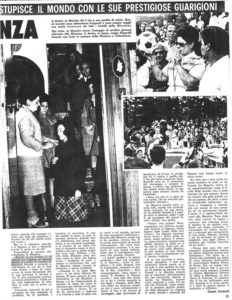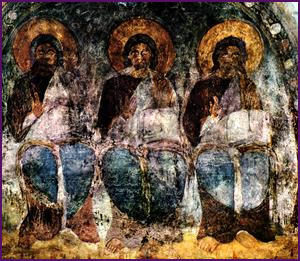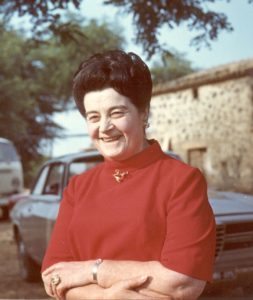LA MISSIONE- LUIGIA PAPARELLI TIMELINE
1908 (December 7): Luigia Paparelli (1908-1984) was born in Scranton (Pennsylvania).
1940s: Paparelli met Basilio Roncaccia (the founder of The Divine Mission).
1937: Luigia received the first “sign” of her future mission, when, afflicted by a somewhat mysterious illness, the Lord had visited and miraculously healed her.
1944 (October 13): Paparelli had a new mystical experience and interpreted it as the Sacred Heart of Jesus giving her the mission to “heal bodies in order to save souls.” The first cure ascribed to Paparelli’s miraculous powers took place.
1944: Paparelli established a group called the Luigia Paparelli Mission (Missione Luigia Paparelli) and started calling her followers the “Brothers of the Mission.” Paparelli became, for her followers, “the Master.”
1970: The Office of the Cardinal Vicar of Rome stated in a letter that Paparelli’s phenomena and “signs” were “superstitious.”
1970-1980: The Mission continued to grow and assumed the name “La Missione – Luigia Paparelli.”
1984 (August 28): Paparelli’s died, surrounded by the Brothers of the Mission in Valmontone (Rome).
1984: Before her death, The Master “summoned” Rina Menichetti Frizza to whom Paparelli addressed her last words. Those Brothers of the Mission, who were called “Apostolini” (“Little Apostles”), recognized Menichetti as Paparelli’s spiritual heir.
2002 (October 6): Rina Menichetti died. After Menichetti’s death, most of the Brothers of the Mission who recognized Menichetti as Paparelli’s spiritual heir, thought there was no successor with the same charisma. A minority of Brothers recognized another person as Menichetti’s spiritual heir.
FOUNDER/GROUP HISTORY
Luigia Paparelli (1908-1984) was born in Scranton (Pennsylvania) on December 7, 1908. In the 1940s, she met Basilio Roncaccia, (the founder of The Divine Mission, who claimed to have received the “divine mission” of sharing with his followers his newly-found healing power, in Rome. Roncaccia and Paparelli shared a devotion to the Holy Trinity, and the idea of helping those who suffered, but their practices were different, and they separated quite soon. The first “sign” of her future mission dates back, in fact, to 1937 when, afflicted by a somewhat mysterious illness, the Lord, she claimed, had visited and miraculously healed her. Seven years of penance followed, and on October 13, 1944, Paparelli had a new mystical experience. She described herself as having been “conquered by a mysterious and violent force,” feeling  “an energy going from heart to fingers, such as the beneficial flux of a new life.” She was persuaded that this was a miracle, and interpreted it as the Sacred Heart of Jesus giving her the mission to “heal bodies in order to save souls.” The first cure ascribed to Paparelli’s miraculous powers took place at Via Ottaviano 43, Rome, in October 1944. [Image at right.] She “signed” the sick with a cross on the forehead, lips, heart, and the afflicted part of their bodies, in the name of the Holy Trinity, and recited a short prayer: “Lord, send the evil spirits away.” The “sign,” Paparelli contended, was not enough, in itself, to achieve both physical and spiritual healing, however; for this, the co-operation of the patients themselves, who should fast, pray, and practice penance was essential. Paparelli also instructed those “signed” by her to visit a Catholic Church in order to confess and receive Holy Communion. In 1970, she had become famous enough to attract the attention of the local Roman Catholic authorities in Rome. The Office of the Cardinal Vicar of Rome, in a letter dated February 27, 1970, stated that Paparelli’s phenomena and “signs” were “superstitious” and could in fact “promote a form of superstition detrimental to religion.” In such phenomena, the declaration went on to say, there was “nothing supernatural.” The Mission continued to grow, however, and assumed the name “La Missione – Luigia Paparelli” (slightly different from the original) following Paparelli’s death on August 28, 1984 in Valmontone (Rome), surrounded by the Brothers of the Mission. After Paparelli’s death, Rina Menichetti Frizza (1928-2002) became the new leader for the majority of the followers.
“an energy going from heart to fingers, such as the beneficial flux of a new life.” She was persuaded that this was a miracle, and interpreted it as the Sacred Heart of Jesus giving her the mission to “heal bodies in order to save souls.” The first cure ascribed to Paparelli’s miraculous powers took place at Via Ottaviano 43, Rome, in October 1944. [Image at right.] She “signed” the sick with a cross on the forehead, lips, heart, and the afflicted part of their bodies, in the name of the Holy Trinity, and recited a short prayer: “Lord, send the evil spirits away.” The “sign,” Paparelli contended, was not enough, in itself, to achieve both physical and spiritual healing, however; for this, the co-operation of the patients themselves, who should fast, pray, and practice penance was essential. Paparelli also instructed those “signed” by her to visit a Catholic Church in order to confess and receive Holy Communion. In 1970, she had become famous enough to attract the attention of the local Roman Catholic authorities in Rome. The Office of the Cardinal Vicar of Rome, in a letter dated February 27, 1970, stated that Paparelli’s phenomena and “signs” were “superstitious” and could in fact “promote a form of superstition detrimental to religion.” In such phenomena, the declaration went on to say, there was “nothing supernatural.” The Mission continued to grow, however, and assumed the name “La Missione – Luigia Paparelli” (slightly different from the original) following Paparelli’s death on August 28, 1984 in Valmontone (Rome), surrounded by the Brothers of the Mission. After Paparelli’s death, Rina Menichetti Frizza (1928-2002) became the new leader for the majority of the followers.
DOCTRINES/BELIEFS
The stated aim of the Mission is the promotion of the “Catholic, Apostolic and Roman religion.” Paparelli became, for her followers, “the Master,” divinely invested with powers to heal and exorcise. She “signed” the sick with a cross on the forehead, lips, heart, and the afflicted part of their bodies, in the name of the Holy Trinity. Paparelli also instructed those “signed” by her to visit a Catholic Church in order to confess and receive Holy Communion.
Luigia Paparelli stated emphatically that she did not regard herself as the founder of a new religion; her faith, she said, was “the one and only religion of Jesus Christ, based on the Ten Commandments.” Rather, Paparelli’s teachings and her supernatural phenomena created a large community of believers who still regard themselves as Roman Catholics, but whose individual perception of their Catholicism differs from person to person and from place to place. Some Brothers of the Mission would simply claim that their feeling toward Paparelli is one of deep gratitude. For other Brothers, however, Paparelli is nothing less than divine and some of them also have an exclusive faith in her healing powers, to the exclusion of all mainstream medicine. These fringes of the larger movement live their lives quite separately from society as a whole, and often break ties with their own families in consequence. The relationship between the Mission and the Roman Catholic hierarchy is different in terms of the different attitudes held by Paparelli’s followers, and those of local parish priests and Bishops.
In her house she also enjoyed spiritual visions of the Master (i.e. Paparelli), whose messages she immediately wrote down for the Brothers. Menichetti told of her encounters with the Master who “takes her on her coach” to “her Kingdom” together with God the Father and the Virgin Mary. In Menichetti’s visions, Paparelli claims that she is the Son (not “the Daughter”) of the Father, and that the Brothers should anticipate her return: “My return will be your liberation.” At the end of each “conversation”, Menichetti received a blessing from the “Holy Trinity:” “In the name of the Father, Luigia the Son, the Holy Spirit, and the Virgin Mary.”
RITUALS/PRACTICES

The Mission’s main centres are located in Gambassi (Tuscany) and San Venanzo, (Umbria), both in Central Italy. “Temples” of the Mission, with statues of Jesus, the Virgin Mary, the Holy Trinityy, [Image at right] and Luigia Paparelli herself, have been built, and are regarded as sacred places where both special yearly festivals and traditional Catholic feasts are celebrated. There are other centres in Italy, in Rome (Lazio), Marche and Sicily, and in several other countries as well (Norway, Denmark, Sweden, Switzerland, France, the U.S.). Brothers of the Mission, and “Little Apostles” in particular, do not proselytize. The Mission’s message is normally spread by someone who has been healed, and who, in turn, propagates its powers of healing. The Brothers of the Mission in Italy (Lazio, Tuscany, Umbria, Marche, and Sicily) and abroad (Norway, Denmark, Sweden, Switzerland, France, the U.S.) total approximately 10,000.
ORGANIZATION/LEADERSHIP

A charismatic figure, Paparelli gathered a significant number of followers around her [Image at right]. In October 1944, she established a group called the Luigia Paparelli Mission (Missione Luigia Paparelli) and started calling her followers the “Brothers of the Mission.” (“Brothers” actually including both male and female disciples). Members of the Mission confirmed their membership by wearing a ring engraved with the symbol of the Holy Trinity. Paparelli became, for her followers, “the Master,” divinely invested with powers to heal and exorcise. She “signed” the sick with a cross on the forehead, lips, heart, and the afflicted part of their bodies, in the name of the Holy Trinity. After Paparelli’s death, problems of succession generated several divisions. According to some witnesses the Master, before her death, “called” Rina Menichetti Frizza (1928-2002) from Orvieto (Central Italy) to whom Paparelli addressed her last words. Those Brothers of the Mission who were called “Apostolini” (“Little Apostles”) recognized Menichetti as Paparelli’s spiritual heir. There are, however, other Brothers of the Mission who assign no particular role to Menichetti. Menichetti has continued to welcome followers to her Orvieto house until her death. After Menichetti’s death, most of Brothers of the Mission who recognized Menichetti as Paparelli’s spiritual heir concluded that there is no successor with the same charisma; a minority of Brothers recognizes another person as Menichetti’s spiritual heir.
ISSUES/CHALLENGES
The relationship with the Roman Catholic hierarchy remains difficult. During her lifetime, Paparelli explicitly saw herself as a possible guide for those who regarded themselves as part of the Roman Catholic Church “spiritually,” but were not prepared to follow the hierarchy in more mundane matters. When, in 1948, during the period of the Cold War, Pius XII (1876-1958), reiterated that Roman Catholics could not be members or followers of the Communist Party and remain at the same time members of the Church in good standing, he generated serious problems in Central Italy (Umbria, Tuscany, Emilia-Romagna, Lazio), an area in which the Italian Communist Party enjoyed widespread support by hundreds of thousands of members. Some of them joined the Mission, in fact, and were welcomed by Paparelli with no preclusion on the grounds of personal political preferences. In some cases, local Catholic parish priests reacted by refusing to administer the sacraments to her followers, whom she then encouraged to meet in prayer centres other than Catholic churches, and to receive “spiritual” non-priestly confession and Communion.
The Brothers of the Mission claim to be Roman Catholics, although their individual attitudes may vary. Some would simply claim that their feeling toward Paparelli is one of deep gratitude, whilst others believe she is “the same as saint Rita of Cascia” (a very popular saint among Italian Catholics). For other Brothers, however, Paparelli is nothing less than divine. For them, she is not only a teacher, a uniquely gifted healer, or even a figure mediating between God and her followers, but a “Divine Master” whose name is “Luigia the Son,” the “reincarnation” in fact of the Son of God, or the “Woman clothed with the Sun” mentioned in the Book of Revelation. It is unclear, and hotly debated, whether Paparelli even called herself “the Son of God,” or whether the title was actually conferred on her posthumously by some enthusiastic followers, some of whom also have an exclusive faith in her healing powers, to the exclusion of all mainstream medicine. These fringes of the larger movement live their lives quite separately from society as a whole, and often break ties with their own families in consequence. Within the movement, some Brothers make a vow of perpetual chastity (even if they are married), or opt for a celibate lifestyle totally focused on the Master and the Mission.
The relationship between the Mission and the Roman Catholic hierarchy is different in terms of the divergent attitudes held by Paparelli’s followers, and those of local parish priests and Bishops. In some Roman Catholic dioceses and parishes the conflict is strong, and Catholic priests refuse administer the sacraments to the Brothers of the Mission. Elsewhere, the relationship is fairly peaceful. In some cases, Mission members have gradually abandoned the beliefs more foreign to Roman Catholicism, whilst other have managed to successfully combine their active membership of the Mission with their uninterrupted and equally active membership of the Catholic Church.
IMAGES
Image #1: Newspaper report of Paparelli performing a miracle healing.
Image #2: Representation of the Holy Trinity.
Image #3: Photograph of Luigia Paparelli.
REFERENCES**
** The material in this profile is taken from the following publications by Raffaella Di Marzio unless otherwise noted.
Di Marzio, Raffaella. 2010. “La Missione-Luigia Paparelli.” Pp. 1918-19 in Religions of the World: A Comprehensive Encyclopedia of Beliefs and Practices, Volume 6, edited by J. Gordon Melton and Martin Baumann. Santa Barbara CA: ABC-Clio.
Di Marzio, Raffaella. 2004. “Movimenti cattolici di Frangia in Italia: dalla Missione Divina di Basilio Roncaccia a Luigia Paparelli.” Pp. 161-67 in Identità religiosa, pluralismo, fondamentalismo, edited by Mario Aletti and Germano Rossi. Torino: Centro Scientifico Editore.
Di Marzio, Raffaella. 2002. “La Missione – Luigia Paparelli.” Pp. 872-74 in Religions of the World: A Comprehensive Encyclopedia of Beliefs and Practices, Volume 4, edited by J. Gordon Melton and Martin Baumann. Santa Barbara, CA: ABC-Clio.
Di Marzio, Raffaella. 2001. “Gruppi ispirati a Basilio Roncaccia e a Luigia Paparelli.” Pp. 66-75 in Enciclopedia delle Religioni in Italia, edited by Massimo Introvigne, PierLuigi Zoccatelli, Nelly Ippolito Macrina, and Verónica Roldán. Leumann (Torino): Elle Di Ci.
SUPPLEMENTARY RESOURCES
Pia Società San Paolo. 1956. Chiese e sette protestanti in Italia. Roma: Edizioni Paoline.
Rina Menichetti’s visions from July 8, 1986 to April 8, 1988 are privately circulated.
Post Date:
26 March 2018
